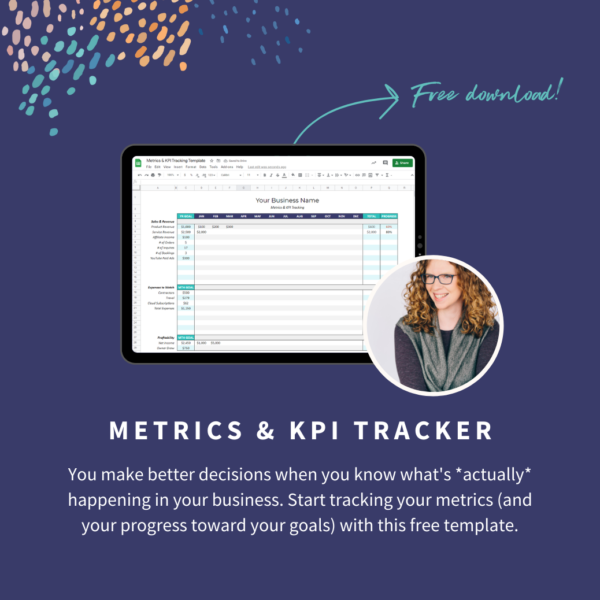You’re growing your business, clients or sales are coming in, you’ve got a growing list of Instagram followers and you are getting requests to go on podcasts or speak at someone’s summit. Things are going great… right?
You may not know this, but all of those things I just listed are actually called “metrics.” Measurements by which you can measure progress. However, put all of those together, and what’s missing? Anything that indicates the business is running well.
What about revenue? Profit? Work hours? Customer satisfaction?
You can have a ton of sales coming in, and have a really awesome group of Instagram followers, but at the end of the day, business success is measured by the actual numbers. What are all those other numbers? Well, they might be vanity metrics.
What is a vanity metric?
Have you ever heard the phrase, “correlation does not imply causation?” Just because two things appear to be connected doesn’t mean they’re statistically related. For example, you could have a huge Instagram following, but that doesn’t mean any of those people are buying from you.
You could have 10 podcasts reach out to you, but that doesn’t mean their audience becomes customers. And you can make 6-figures in revenue, but bring home $1,000 in profit.
Just because your schedule is full and people seem interested, it doesn’t mean your business is on sound footing. Those are all vanity metrics: numbers that don’t matter, can easily be manipulated, or don’t actually help you reach your goals.
Vanity metrics are, unfortunately, becoming a problem in the online business world. People sell their 6-figure launch plan (without sharing their actual profit margins), or tell you that you can grow your Instagram following (but don’t have a plan for turning them into customers).
Vanity metrics are sneaky. They sound important, but they distract you and pull you in too many directions. Are you using vanity metrics in your business? Let’s find out.
Common vanity metrics you might be using
Instagram followers
I’ll cut right to the chase with this first one. You don’t need a million Instagram followers to have a thriving business. I know people who have about 500 followers and make six figures a year (in profit). They know that Instagram is great for building awareness, but their customers or clients come from somewhere else.
Please note: there are always people who do turn their Instagram followers into customers, and that’s a good reason for them to keep focusing on growing their count.
Social media frequency
Another “success signal” I hear about a lot is how frequently someone posts. Surely, if they’re posting every day and doing Reels or creating long-form LinkedIn articles, they’re making a lot of money and their social followers are turning into paying customers!
Let’s think about this. If someone has a ton of time to spend on social media, do you think they’re busy with their client work or products? On the other hand, they may see that social media pays off for them, so they invest more time into it. But they better have the clear numbers to prove it.
The proof? I have a client who didn’t post on Instagram or Facebook for 18 months… and she sold over half a million dollars during that time.
Another scenario: I’ve seen people use just their social media to promote a new offer, and hit 6-figures in sales. It all depends on the business.
Email list size
One time, I signed on a client who said he had 20,000 subscribers. When I got into his email system, I quickly saw an average open rate of 5%. We spent a month cleaning out his list, and found out he really only had 4,000 engaged subscribers. Keeping all those unengaged subscribers on the list cost him money (email tools aren’t cheap!), impacted the deliverability of his emails to people who actually wanted to read them, and affected our ability to make accurate projections of expected revenue for planned launches.
Yes, a big email list that has high engagement is great. But solely looking at the number of subscribers isn’t enough and can skew more important data.
Website traffic
We are no longer in the early days of the internet when blog views and website visits helped drive revenue from ads. Most of us don’t have ads on our website or blogs anymore (ew), so why are we still so attached to the number of website visitors we receive?
Website traffic doesn’t tell the whole story — even if you’re looking at traffic to a specific page. Instead, look at things like time spent on the page, bounce rate, link clicks, and behavior. What did people do when they visited your website or page? Which buttons did they click? What was the second page they visited? That’s where the real metrics start.
Which metrics matter… really?
As I’ve talked about before, the numbers don’t lie. To be honest, the numbers that matter to you are different from the numbers that matter to someone else. Your business is unique, and so are your offers, audience, and team. You don’t know what’s working until you track it — and actually look at what the numbers say.
I know that deciding what to look at and understanding what it all means, feels overwhelming. You’re trying to run a business, not a data collection center. That’s why I created a simple Metric & KPI Tracking Template that gives you a few metrics to start with, plus tips on how to customize this for metrics specific to your brand.
I use this tracking spreadsheet with clients in my day-to-day work, and it has helped many teams see — in clear numbers — what is working and what’s just not. When you start tracking the numbers, you’ll be able to make advised decisions for your own business, and avoid putting more time, money, or energy into tools and strategies that aren’t working for you.

Be the first to comment